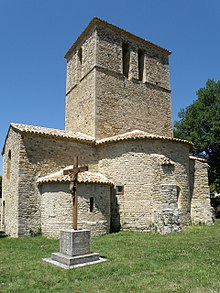Sainte-Jalle
|
Sainte-Jalle Santa Jala |
||
|---|---|---|
|
|
||
| region | Auvergne-Rhône-Alpes | |
| Department | Drôme | |
| Arrondissement | Nyons | |
| Canton | Nyons et Baronnies | |
| Community association | Baronnies en Drôme Provençale | |
| Coordinates | 44 ° 21 ′ N , 5 ° 17 ′ E | |
| height | 376–1,025 m | |
| surface | 18.16 km 2 | |
| Residents | 308 (January 1, 2017) | |
| Population density | 17 inhabitants / km 2 | |
| Post Code | 26110 | |
| INSEE code | 26306 | |
 Sainte-Jalle - town view |
||
Sainte-Jalle ( Occitan : Santa Jala ) is a place and a French community with 308 inhabitants (at January 1, 2017) in the Drome region, in the region of Auvergne Rhône-Alpes . The place is named after St. Named Galla of Valence .
location
The place Sainte-Jalle is located in the spacious and fertile valley of the Ennuye in the south of the Drôme department at an altitude of approx. 400 m above sea level. d. M .; the next larger city, Nyons , is approx. 18 km (driving distance) to the west. Sainte-Jalle does not officially belong to the municipalities in the " Parc naturel régional des Baronnies Provençales ", but is enclosed by it.
history
Several Gallo-Roman altars, which served the cult of the Baginati (mother goddesses ), were found near the church. In the 7th century, monks from the Bodon Abbey from Saint-May settled down and founded a monastery called Sainte-Galle, which was converted into a Cluniac priory in the 11th or 12th century and later incorporated into the Sisteron diocese . During the Wars of Religion (1562-1598) the then still the accepted Protestantism pendant Duke of Lesdiguières the location (1586).
Population development
| year | 1800 | 1851 | 1901 | 1954 | 1999 | 2017 |
|---|---|---|---|---|---|---|
| Residents | 531 | 720 | 520 | 333 | 269 | 308 |
The population decline in the 20th century is mainly due to the loss of jobs as a result of the phylloxera crisis in viticulture and the mechanization of agriculture .
Attractions
- The most significant Romanesque church of the Baronnies is the dreiapsidiale and built on a rectangular plan Vierungsturm provided Église Notre-Dame-de-Beauvert . It was built as a priory church in the first half of the 12th century on the site of a previous building, which in turn replaced a Roman temple . The stones used in the construction were only slightly hewn, but at least the effort to achieve uniform stone layers is recognizable. The west portal, designed according to a triumphal arch scheme, shows - an exception in the region - a figurative tympanum depicting a rooster drinking from a goblet, a pilgrim with a staff and bag, a man with a bird on his shoulder and a fiddle player . The stone lintel and the archivolt arches show vegetal ornaments. The crossing area is slightly increased compared to the other room segments; the central apse shows a blind arcade structure and three rows of darker stones in the apse calotte . Church construction has been recognized as a monument historique since 1931 .
- The castle ( château ) of the place probably dates from the 13th / 14th centuries. Century. It essentially consists of a castle gate with a weir bay , a castle courtyard and a two-storey residential wing ( corps de logis ).
- The chapel of Our Lady of Mercy ( Chapelle Notre-Dame-de-Pitié ) is also worth seeing .
- outside
- The former Chapelle Sainte-Anastase is located about 2 km south of the village on private property. The late Romanesque building was recognized as a Monument historique in 1984 .
economy
The inhabitants of the place known as the "granary of the baronnies" lived for centuries as a self-sufficient living from agriculture (agriculture and cattle breeding). Wine was also grown; the place still has the right to market its grapes through the Appellations Comtés Rhodaniens , Coteaux des Baronnies , Mediterranée and Drôme ; There are still numerous vineyards in the vicinity of the place and three winemakers are still based in the place. Growing olives, apricots, cherries and apples is also important. Since the last decades of the 20th century, tourism has played an important role in the economic life of the place in the form of renting holiday apartments ( gîtes ) .
Web links
- Sainte-Jalle - photos + brief information (French)
- Sainte-Jalle - photos, videos + information (French)
- Sainte-Jalle, church - photos, + brief information (French)
Individual evidence
- ↑ Église, Sainte-Jalle in the Base Mérimée of the French Ministry of Culture (French)
- ↑ Chapelle Sainte-Anastase, Sainte-Jalle in the Base Mérimée of the French Ministry of Culture (French)
- ↑ Sainte Jalle - Viticulture






